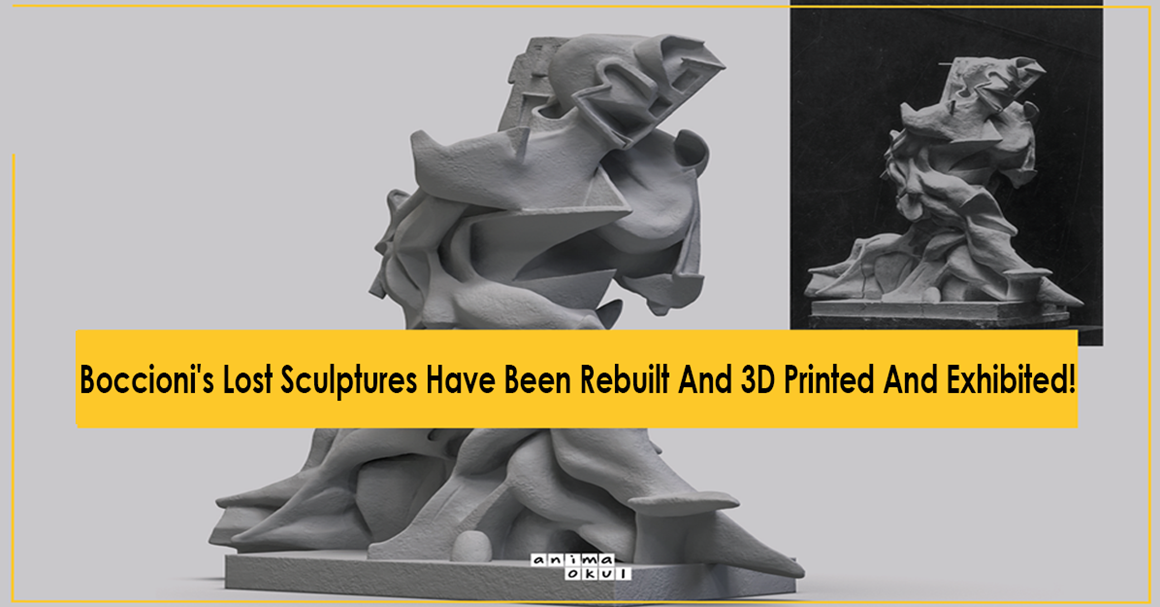BOCCIONI'S LOST SCULPTURES HAVE BEEN REBUILT AND 3D PRINTED AND EXHIBITED!

Umberto Bocciani (1882-1916) was an influential Italian painter and sculptor. He helped shape the futurism movement as one of the key figures in its revolutionary aesthetic. He was born in Reggio Calabria and settled in Milan after completing his art education. In early 1910 he met F. T. Marinetti, who had published the Manifesto del Futurismo (Manifesto of Futurism) the previous year. Boccioni became the main theorist of the new artistic movement, which glorified modernity and emphasized the technological and industrial victory of humanity over nature. Although he had no previous experience, he decided to become a sculptor in 1912 after visiting various studios in Paris. In a short period of time, he had made 10-15 major works (sculptures), including one of his iconic works, "Unique Forms of Continuity in Space."
Three similar “striking” figure sculptures by Boccioni before this work:
- Synthesis of Human Dynamism
- Speeding Muscles
- Spiral Expansion of Muscles in Motion
With all these works, he tries to solve the problem of capturing a “synthetic continuity” of movement (integration of surrounding architectural elements, even the effect of perceived air) in his sculptures. His first sculpture, Synthesis of Human Dynamism, has a complexity that he gradually subtracts from his later sculptures. His second statue, Muscles Accelerating, no longer has hair, nipples, and navel. Left arm length is reduced and architectural elements are limited to a house/head and a spine protruding from the chest. In his next sculpture, the Spiral Expansion of Muscles in Motion further reduces the arms and preserves only the principles of architectural structures. Finally, in his Unique Forms of Continuity in Space sculpture, Boccioni perfects the simplicity of step-by-step movement.
,7246_big.png)
Boccioni never saw his work appreciated. Just three years after creating these statues, he fell off his horse and died during a military training exercise. More tragically, in 1927, three striking statues were destroyed by the artist who hid them after Boccioni's death.
The Unique Forms of Continuity in Space sculpture was salvaged because it was previously sold. This piece was later cast in bronze and one of them was sold at Christie's auction house in New York at the end of 2019. The work was estimated to fetch $4.5 million, but it sold for an incredible $16 million. This shows how valuable Boccioni's works are today.
Digital Sculptor and Illustrator Anders Raden was involved in the project when he decided to sculpt Muscles Accelerating. Raden is an artist with many years of experience using Zbrush, and his work ranges from anatomical sections to dinosaurs and sea monsters. Since she admires Boccioni, she models the Sculpting Muscles sculpture on the Zbrush program and posts it on her Twitter account. Before Raden, another digital artist, Matt Smith, did a study for Spiral Expansion of Muscles in Motion. When Matt Smith sees Ander Raden's post, he contacts Anders. In this way, they decide to collaborate to reconstruct the stunning sculptures.
They think it would be interesting to make plaster adaptations of Boccioni's sculptures that show a kind of evolutionary development towards "Unique Continuity in Space". They decide to experience the exhibition of these works in the art gallery.
Matt Smith travels to London to meet with the Estorick Museum to see if they want to be interested. The museum also gives the artists a date for the opening of the Boccioni - Lost Sculptures Recreation exhibition. They find original photographs of the works, and this is a very difficult process. Most of the 30 or so photographs of the sculptures have been published only once or twice in private collections in Italy, and some in obscure exhibition catalogues.
Artist Ander Raden describes her Zbrush experience:
“I have added the resulting photos to the Zbrush “Image Plane” screen as a reference. In this way, reference images can be quickly misdirected, which is crucial for comparing complex details from different angles during the modeling process. With Zbrush's ability to change the model transparency, I easily used tracing the contours of the photos. The brushes I use most often are DamStandard; Move Topology; It was Polish and Inflate. The Sculptris Pro mod was a real life saver for restoring topology where the polygons were too stretched or squashed together. Complex mesh details, such as the hair on the Synthesis of Human Dynamism, are reflected on the model by making an alpha from the hair section in the photo. There was so much between Matt and I that we discussed how to solve different anatomical problems. Finally, the 3D Print Hub plugin was used to resize the sculptures and exported as .stl files
The models were printed using PLA printing and Polystyrene techniques by the 3D Printer company in England. For the first time since 1927, these extraordinary sculptures have been exhibited in life-size.
Source: Artwatch, Pixologic, Zbrush Central